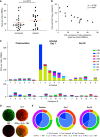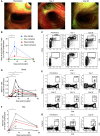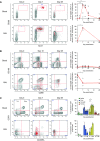Innate-like Gene Expression of Lung-Resident Memory CD8+ T Cells during Experimental Human Influenza: A Clinical Study
- PMID: 34256007
- PMCID: PMC8528532
- DOI: 10.1164/rccm.202103-0620OC
Innate-like Gene Expression of Lung-Resident Memory CD8+ T Cells during Experimental Human Influenza: A Clinical Study
Abstract
Rationale: Suboptimal vaccine immunogenicity and antigenic mismatch, compounded by poor uptake, means that influenza remains a major global disease. T cells recognizing peptides derived from conserved viral proteins could enhance vaccine-induced cross-strain protection. Objectives: To investigate the kinetics, phenotypes, and function of influenza virus-specific CD8+ resident memory T (Trm) cells in the lower airway and infer the molecular pathways associated with their response to infection in vivo. Methods: Healthy volunteers, aged 18-55, were inoculated intranasally with influenza A/California/4/09(H1N1). Blood, upper airway, and (in a subgroup) lower airway samples were obtained throughout infection. Symptoms were assessed by using self-reported diaries, and the nasal viral load was assessed by using quantitative PCR. T-cell responses were analyzed by using a three-color FluoroSpot assay, flow cytometry with MHC I-peptide tetramers, and RNA sequencing, with candidate markers being confirmed by using the immunohistochemistry results for endobronchial biopsy specimens. Measurements and Main Results: After challenge, 57% of participants became infected. Preexisting influenza-specific CD8+ T cells in blood correlated strongly with a reduced viral load, which peaked at Day 3. Influenza-specific CD8+ T cells in BAL fluid were highly enriched and predominantly expressed the Trm markers CD69 and CD103. Comparison between preinfection CD8+ T cells in BAL fluid and blood by using RNA sequencing revealed 3,928 differentially expressed genes, including all major Trm-cell markers. However, gene set enrichment analysis of BAL-fluid CD8+ T cells showed primarily innate cell-related pathways and, during infection, included upregulation of innate chemokines (Cxcl1, Cxcl10, and Cxcl16) that were also expressed by CD8+ cells in bronchial tissues. Conclusions: CD8+ Trm cells in the human lung display innate-like gene and protein expression that demonstrates blurred divisions between innate and adaptive immunity. Clinical study registered with www.clinicaltrials.gov (NCT02755948).
Keywords: CD8+ T cell; controlled human infection; influenza; resident memory.
Figures








Comment in
-
Lung-Resident Memory CD8+ T Cells in Human Influenza: How Innate Are They?Am J Respir Crit Care Med. 2021 Oct 1;204(7):753-755. doi: 10.1164/rccm.202106-1508ED. Am J Respir Crit Care Med. 2021. PMID: 34352192 Free PMC article. No abstract available.
References
-
- World Health Organization. Geneva, Switzerland: World Health Organization; 2018. https://www.who.int/news-room/fact-sheets/detail/influenza-(seasonal)
-
- Krammer F, Palese P. Advances in the development of influenza virus vaccines. Nat Rev Drug Discov. 2015;14:167–182. - PubMed
-
- Pebody R, Warburton F, Ellis J, Andrews N, Thompson C, von Wissmann B, et al. Low effectiveness of seasonal influenza vaccine in preventing laboratory-confirmed influenza in primary care in the United Kingdom: 2014/15 mid-season results. Euro Surveill. 2015;20:21025. - PubMed
-
- Koutsakos M, Illing PT, Nguyen THO, Mifsud NA, Crawford JC, Rizzetto S, et al. Human CD8+ T cell cross-reactivity across influenza A, B and C viruses. Nat Immunol. 2019;20:613–625. - PubMed
Publication types
MeSH terms
Substances
Associated data
Grants and funding
LinkOut - more resources
Full Text Sources
Medical
Research Materials

